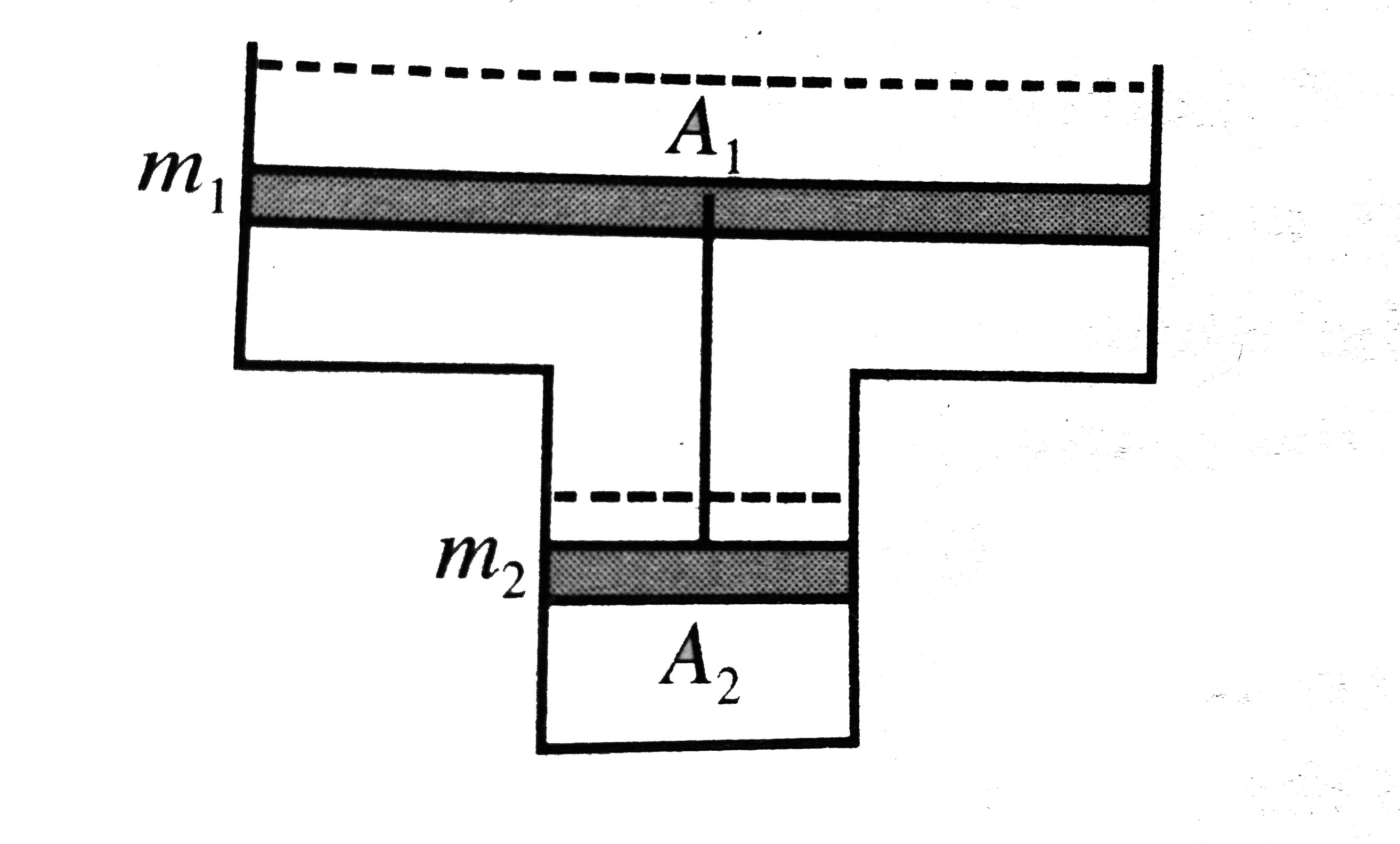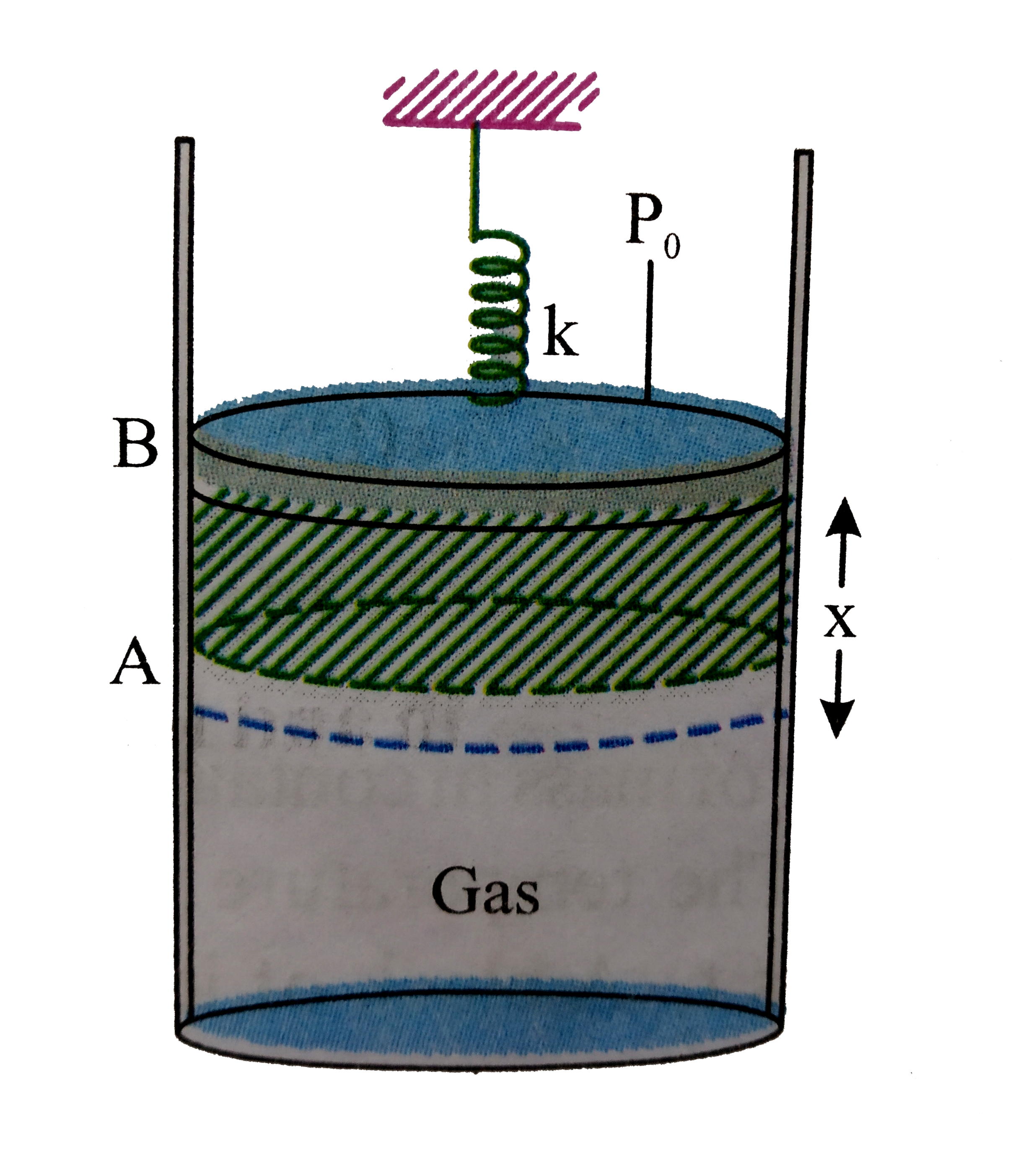A vertical hollow cylinder contains an ideal gas. The gas is enclosed by a 5kg movable piston with an area of cross-section 5×10−3m2. Now, the gas is heated slowly from 300K to 350K and the piston rises by 0.1m. The piston is now clamped at this position and the gas is cooled back to 300K. Find the difference between the heat energy added during heating process and energy lost during the cooling process. (1atm pressure=105Nm−2]
Given, mass of piston M= 5kg, cross sectional area of piston A=5×10−3m2,g=10ms−2 and atmospheric pressure P0=105Nm−2
The initial pressure of the gas in the cylinder is
P= atmospheric pressure + pressure due to weight Mg of piston
=P0+MgA or P=105+5×105×10−6=1.1×105Nm−2
When the piston rises by x = 0.1 m, the increase in the volume of the gas is
ΔV=Ax=(5×10−3)×0.1=5×10−4m3
Thus work done by the gas is
W=∫V2V1PdV
or =P(V2−V1)
=1.1×105×5×10−4=55 J
If ΔU is the increase in the internal energy during heating,then from the first law of thermodynamics, the heat energy supplied to the gas is given as
Q=ΔU+W=(ΔU+55) joule
Since the piston is clamped, the volume of the gas remains constant during cooling. Hence work done during cooling is
zero.
As the gas is cooled back to the initial temperature, the change in the internal energy during cooling is
ΔU'=−ΔU
Thus heat energy lost by the gas during cooling is
Q'=ΔU'+W'=−ΔU+0=−ΔU
The difference between heat energy added during heating and heat energy lost during cooling is
ΔQ=Q−Q'=(ΔU+55)−ΔU = 55 joule .
Topper's Solved these Questions
- BOOK - PHYSICS GALAXY - ASHISH ARORACHAPTER - THERMODYNAMICS LAWS & SPECIFIC HEATS OF GASES EXERCISE - Discussion Question17videos
THERMODYNAMICS LAWS & SPECIFIC HEATS OF GASES
- BOOK - PHYSICS GALAXY - ASHISH ARORACHAPTER - THERMODYNAMICS LAWS & SPECIFIC HEATS OF GASES EXERCISE - Conceptual MCQs Single Option Correct21videos
THERMODYNAMICS LAWS & SPECIFIC HEATS OF GASES
- BOOK - PHYSICS GALAXY - ASHISH ARORACHAPTER - PHOTOELECTRIC EFFECT AND MATTER WAVESEXERCISE - Unsolved numerical problems42videos
PHOTOELECTRIC EFFECT AND MATTER WAVES
- BOOK - PHYSICS GALAXY - ASHISH ARORACHAPTER - WAVE OPTICSEXERCISE - Unsolved Numerical Problems28videos
WAVE OPTICS
Similar Questions
A cylinder of ideal gas is closed by an 8kg movable piston of area 60cm2. The atmospheric pressure is 100kPa. When the gas is heated form 30∘C to 100∘C, the piston rises 20 cm. The piston is then fastened in the place and the gas is cooled back to 30∘C. If ΔQ1 is the heat added to the gas during heating and ΔQ2 is the heat lost during cooling, find the difference.
View SolutionThe pressure of a gas contained in a cylinder with a movable piston is 300 Pa. The area of the piston is 0.5m2. Calculate the force that is exerted on the piston.
View Solution
Knowledge Check
- Question 1 - Select One
When 1.5 mol of a gas is heated at constant volume from 300 K to 350 K and the heat supplied to the gas is 750 J then the correct option is
Aq=ΔU=750J,w=0Bq=w=750J,ΔU=0Cq=w=750J,ΔU=−750JDq=750J,w=ΔU=−750J - Question 2 - Select One
N2 gas is heated from 300 kg temperature to 600 k through an isobaric process. Then find the change in the entropy of the gas (n = 1 mole )
A10 J/kB20 J/kC30 J/kD40 J/k - Question 3 - Select One
Two mole of an ideal monatomic gas are confined within a cylinder by a mass less spring loaded with a frictionless piston of negligible mass and crossectional area 4×10−3m2. The gas is heated by a heater for some time. During this time the gas expands and does 50J of work in moving the piston through a distance of 0.01m. The temperature of gas increases by 50k.

Heat supplied by heater during this process isA129.65JB1296.5JC12.96JD250J
An ideal monatonic gas is confined in a cylinder by a spring-loaded piston of cross section 8.0×10−3m2.initially the gas is at 300K and occupies a volume of 2.4×10−3m−3 and the sprinng is in its relaxed state. The gas is heated by a small heater until the piston moves out slowly by 0.1m. Calculate the final tenoerature of the gas. The force constant if the spring is 8000Nm−1,and the atmospheric pressure is 1.0×105Nm−2.Htecyl∈derandtheπs→narethermally∈sylated.Theπs→nandthespr∈garemass≤ssandthereisnoictionbetweentheπs→nandthecyl∈der.Neg≤ctanyheat−lossthroughthe≤adwiresoftheheater.Theheat∩acityoftheheatercoilis¬ligib≤.
 View Solution
View SolutionA gas is enclosed in a cylindrical vessel fitted with a frictionless piston.the gas is slowly heated for some time. During the process, 10 J of heat is suopplied and the piston is found to move out 10cm. Find the increase in the internal energy of the gas , the area of cross section of the gas, the area of cross section of the cylinder=4 cm^(4) and the atmospheric pressure =100kPa.
View SolutionTwo moles of an ideal gas are contained in a vertical cylinder with a frictionless piston. The piston is slowly displaced so that expansionin gas is isothermal at temperature T0=400K. find the amount of work done in increasing the volume to 3 times.t ake atmospheric pressure =105N/m2
View SolutionConsider a vertical tube open at both ends. The tube consistss of two parts, each of different cross sections and each part having a piston which can move smoothly in respective tubes. The two piston which can move smoothly in respective tube wire. The piston are joined together by an inextensible wire. The combined mass of the two piston is 5kgand area of cross section of the upper piston is 10cm2 greater than that of the lower piston. Amount of gas enclosed by the pistons is 1mol. When the gas is heated slowly, pistons move by 50cm. Find the rise in the temperature of the gas in the form X/RK, where R is universal gas constant. Use g=10m/s2 and outside pressure =105N/m2).
 View Solution
View SolutionTwo mole of an ideal monatomic gas are confined within a cylinder by a mass less spring loaded with a frictionless piston of negligible mass and crossectional area 4×10−3m2. The gas is heated by a heater for some time. During this time the gas expands and does 50J of work in moving the piston through a distance of 0.01m. The temperature of gas increases by 50k.

Change in internal energy of the gas isView Solution

